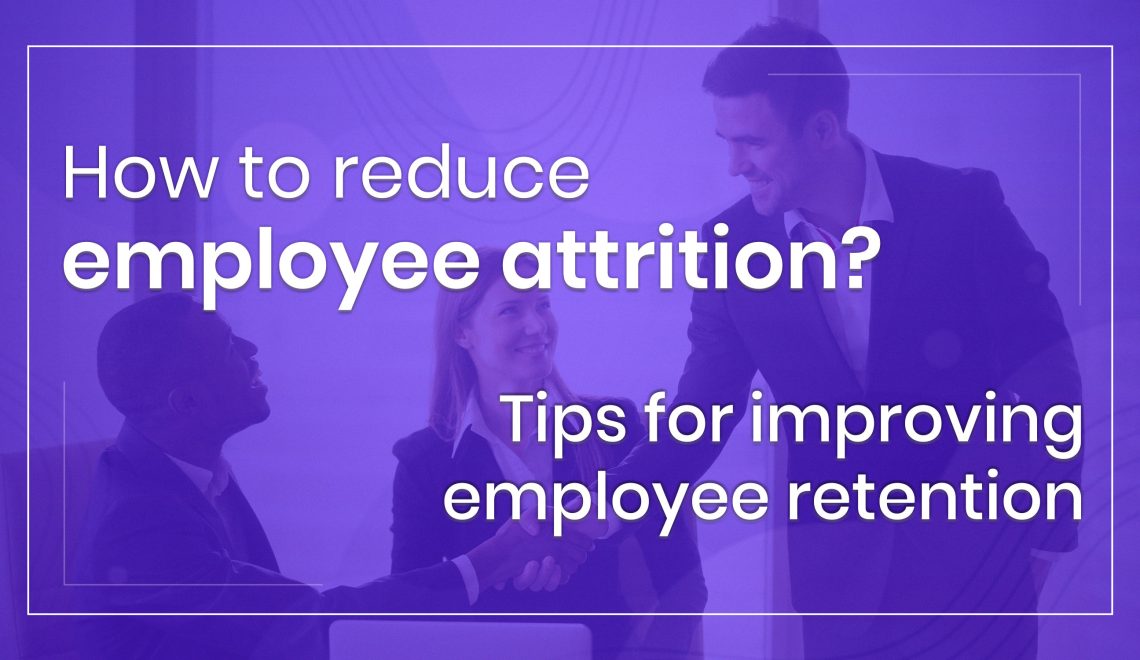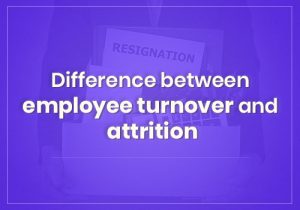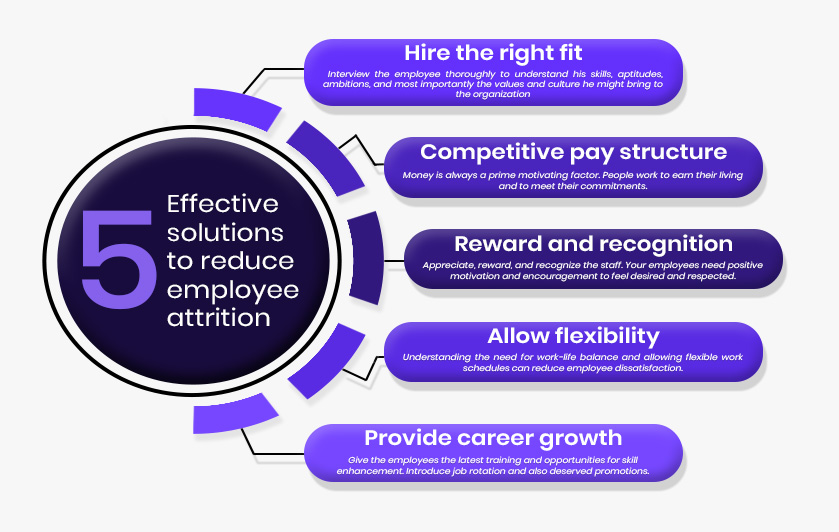
For me, employees are lifetime assets !!! Once you find the right person build a relationship and retain them for a long. This is my motto in human resource management.
Give your employees excellent growth opportunities within your company, help them build their skills, and participate actively in shaping their careers. Create an environment where they identify their personal growth with the growth of the organization. You are sure to have a loyal workforce, responsive to challenges, and committed to the business goals and objectives.
I would say that high employee attrition is the single most obstacle in a company’s growth path. It throws unexpected surprises and turns in the business process when key performers leave and replacements fall below the standards or end up as a misfit in the organization. The cost of employee attrition is high and businesses should keep this point on the top list of their agenda and devise an effective process for reducing employee attrition.
How to reduce employee attrition – retention is cheaper, replacement is expensive
Recruiting and retaining the right talent is a challenging task in today’s business environment. A business invests time, effort, and money to find the right person, train them for the job, and to shape them according to the values and culture of the company. Hence, when there is frequent employee attrition it has a highly damaging impact on the business because of the loss of investment that was spent on recruiting and training the employee. The business also will need to incur an additional expense in finding new talent.
Possible causes of employee attrition
Employee attrition can be attributed to a number of factors many of which are preventable. Low compensation, heavy workload, workplace stress, limited feedback and recognition, and poor work-life balance are a few of them. Restrictive workplace culture and authoritative leadership style can also contribute to employee attrition. As employees are constantly seeking career growth, poor training and development plans in an organization also lead to employee attrition. The human resource department should analyze the employee attrition reasons and identify the steps that help to reduce employee attrition in the organization and implement them proactively. Technology allows for accurate employee attrition rate prediction with tools such as employee attrition analysis using predictive analytics.
What is the difference between employee turnover and attrition?

Employee attrition vs turnover – Even though the terms turnover and attrition are used interchangeably, there are certain key differences between the two. Turnover refers to all terminations in an organization including the ones that are refilled while attrition refers to the positions that are eliminated completely or the long-term vacancies. Attrition can also be involuntary when the company decides to separate itself from the employee. A layoff is a good example of involuntary employee attrition.
How to calculate the employee attrition rate?
You can easily calculate using the employee attrition rate formula by dividing the average number of employees who leave the organization in a time period by the average number of employees in that same time period and multiplying the result by 100.
Challenges in employee attrition
Employee mobility is increasing and the availability of alternative career options makes job hopping easier. In this context reducing employee attrition is tough and it would be good for a business to understand the key challenges using employee attrition rate analysis before devising steps for employee retention.
- Money matters – Monetary dissatisfaction is one of the leading causes of attrition. Organizations might have a fixed salary structure for each level workforce. When an employee starts expecting higher compensation due to the availability of better opportunities elsewhere or because they feel they are not being compensated appropriately for their skills or quality, it can lead to dissatisfaction and attrition.
- Better employment opportunities – The growth of the internet, the emerging concept of remote jobs, and higher employee mobility are causing cut-throat competition for hiring talent. Better growth opportunities and attractive offers from competitors are too lucrative for most employees to resist.
- Boredom and routine – During the initial stages, a job might have been interesting and challenging. But with time it becomes monotonous and employees could get frustrated with the routine. Ideally, regular job rotation should become a standard practice in organizations.
- Issues with the supervisor – This is a common reason for employees to quit their job. Supervisors need to be empathetic and able to gain the trust and confidence of the employees.
- Stress and poor work-life balance – Job stress is the key factor behind attrition. High stress and the resulting work-life imbalance forces many employees to look for alternative options.
- Communication issues – If there is no clear and transparent communication within an organization, employees might feel left out and also be unclear on their goals, tasks, and expectations. They might become frustrated as a result. Lack of feedback also could lead to job dissatisfaction.
Effective solutions to reduce employee attrition
Reducing the employee attrition problem requires just a few simple changes within your organization.

- Hire the right fit – Interview the employee thoroughly to understand his skills, aptitudes, ambitions, and most importantly the values and culture he might bring to the organization. Employee behaviour is a key factor in a team’s success. An employee who doesn’t fit into an organization’s culture might end up as misalignment and definitely quit at one point or the other.
- Competitive pay structure – Money is always a prime motivating factor. People work to earn their living and to meet their commitments. If the pay and benefits structure is not competitive you cannot blame the employees for searching higher paying alternatives.
- Reward and recognition – Appreciate, reward, and recognize the staff. Your employees need positive motivation and encouragement to feel desired and respected. Positive words and praise can boost employee morale. Ensure to have a transparent reward recognition program in place.
- Allow flexibility – Understanding the need for work-life balance and allowing flexible work schedules can reduce employee dissatisfaction. When they get time to take care of their personal commitments along with work it reduces frustration.
- Provide career growth – Give the employees the latest training and opportunities for skill enhancement. Introduce job rotation and also deserved promotions. Have regular discussions with the employees to understand their aspirations and clearly communicate to them the career path they would gain by sticking with the organization.
How does the employee attrition rate affect an organization?
Employee attrition is detrimental to an organization’s growth. Replacement is a costly affair and causes a loss of money, time, and effort. Attrition also impacts overall productivity.
- Recruitment and training cost – Finding talent is tedious and expensive involving advertisements, job portals, recruitment agencies, interviews, and follow-ups. Replacing a lost employee will require the business to incur all these costs a second time. And, there is also the training cost involved to onboard and shape the employee to the system and process.
- Lost productivity – When an employee leaves there might come a gap before the new hire joins. Existing employees are forced to work hard for a while and reduce their productivity. Again the new hire needs time to adapt to the organization’s culture, learn the business goals, and understand the job responsibilities. The time a new hire might take to put in his best performance is a loss of productivity for the company.
- Higher salary for replacing – Many times the replacement salary is 10 to 20 % higher than the salary that was being paid to the employee who is quitting. Scarce skills might require an even higher hike in salary.
- Customer dissatisfaction – Customer’s might prefer to interact with a particular employee. If they are not happy with the new hire, they might become frustrated and move to the competitors.
Attrition is not always negative. When employees quit it can bring new talent, fresh ideas, abilities, and aptitudes thereby preventing the organization from becoming stagnant. At times if the employee has a negative influence on the work culture, termination might be desirable.
Are your employees leaving even after your best efforts? I recommend understanding the reason during the exit interview. This would help to identify any hidden issues that you have missed addressing.
What are the types of employee attrition?
The common types of employee attrition are voluntary attrition, involuntary attrition, internal attrition, and external attrition.
Are employee turnover and attrition the same?
Employee attrition refers to the long-term separations from the organization while employee turnover refers to the vacancies that are not long-term in nature and are refilled.
What is a bad employee retention rate?
An employee retention rate of 90% is generally considered good for any organization.
What are the two types of attrition?
Two main types of attrition are voluntary attrition and involuntary attrition.
What are the 5 modes of attrition?
The 5 modes of attrition are voluntary attrition, attrition due to retirement, involuntary attrition, demographic-specific attrition, and internal attrition.



